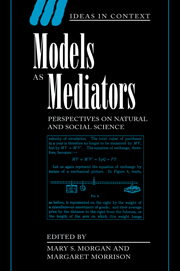Book contents
- Frontmatter
- Contents
- List of contributors
- Preface
- 1 Introduction
- 2 Models as mediating instruments
- 3 Models as autonomous agents
- 4 Built-in justification
- 5 The Ising model, computer simulation, and universal physics
- 6 Techniques of modelling and paper-tools in classical chemistry
- 7 The role of models in the application of scientific theories: epistemological implications
- 8 Knife-edge caricature modelling: the case of Marx's Reproduction Schema
- 9 Models and the limits of theory: quantum Hamiltonians and the BCS models of superconductivity
- 10 Past measurements and future prediction
- 11 Models and stories in hadron physics
- 12 Learning from models
- Index
11 - Models and stories in hadron physics
Published online by Cambridge University Press: 10 March 2010
- Frontmatter
- Contents
- List of contributors
- Preface
- 1 Introduction
- 2 Models as mediating instruments
- 3 Models as autonomous agents
- 4 Built-in justification
- 5 The Ising model, computer simulation, and universal physics
- 6 Techniques of modelling and paper-tools in classical chemistry
- 7 The role of models in the application of scientific theories: epistemological implications
- 8 Knife-edge caricature modelling: the case of Marx's Reproduction Schema
- 9 Models and the limits of theory: quantum Hamiltonians and the BCS models of superconductivity
- 10 Past measurements and future prediction
- 11 Models and stories in hadron physics
- 12 Learning from models
- Index
Summary
INTRODUCTION
Working in various physics departments for a couple of years, I had the chance to attend several PhD examinations. Usually, after the candidate derived a wanted result formally on the blackboard, one of the members of the committee would stand up and ask: ‘But what does it mean? How can we understand that x is so large, that y does not contribute, or that z happens at all?’ Students who are not able to tell a ‘handwaving’ story in this situation are not considered to be good physicists.
Judging from my experience, this situation is typical not only of the more phenomenological branches of physics (such as nuclear physics) but also for the highly abstract segments of mathematical physics (such as conformal field theory), though the expected story may be quite different. In this paper, I want to show that stories of this kind are not only important when it comes to finding out if some examination candidate ‘really understands’ what he calculated. Telling a plausible story is also an often used strategy to legitimate a proposed model.
If I am right about this, empirical adequacy and logical consistency are not the only criteria of model acceptance. A model may also be provisionally entertained (to use a now popular term) when the story that goes with it is a good one. But what criteria do we have to assess the quality of a story? How do scientists use the method of storytelling to convince their fellow scientists of the goodness of their model?
- Type
- Chapter
- Information
- Models as MediatorsPerspectives on Natural and Social Science, pp. 326 - 346Publisher: Cambridge University PressPrint publication year: 1999
- 45
- Cited by

